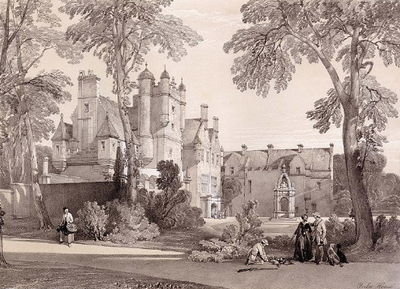Annotation:Pinkie House
Back to Pinkie House
PINKIE HOUSE. AKA and see "Fair Scotland! dear as life to me," "Rothes' Lament." Scottish, Slow Air. E Flat Major (Johnson-McLean): G Major (McGibbon, O’Farrell). Standard tuning (fiddle). AABB. George Farquhar Graham (Songs of Scotland, 1853, p. 89) explains the air was anciently called "Rothes' Lament," although only the tune and title survived. The melody was printed in Thomson's Orpheus Caledonius (1725) as the vehicle for the song "As Sylvia in a forest lay," one of the first compositions of David Mallet. Under the title "Pinkie House" it appeared in the fifth volume of Watts' Musical Miscellany (pp. 174-175) wherein the melody is attributed to Queen Mary's tragic secretary, David Rizzo, to whom a great number of tunes are ascribed with little evidence. A sonata based on the air "Pinkie House" was composed (around 1736-40) by Charles McLean and revised by Robert Mackintosh (c. 1745-1807) who, Pulver (1992) says, updated the genre in the 1770’s with new bowing styles and occasional harmonic experiments. It also appears in the 1740 MacFarlane Manuscript in drawing-room style, and in the [James] Gillespie Manuscript of Perth (1768).

Pinkie House [1] is located in Musselburgh, on the east side of the River Esk. It began as a Medieval tower built in 1390 and was greatly extended in 1613 by Alexander Seton (1555 - 1622), 1st Earl of Dunfermline, for use as his residence. Pinkie House changed hands several times over the centuries and still exists as the site of a school, Loretto. It features the famous Painted Gallery, a 70 ft long chamber with a splendid painted wooden ceiling. The mansion was mentioned in Sir Walter Scott’s work Waverly (Chapter 49), and was the location of a ball for Bonnie Prince Charlie the night after the Battle of Prestonpans in 1745 (being then the residence of the Marquis of Tweeddale).
Source for notated version: the McLean Collection, 1772 [Johnson].
Printed sources: Johnson (Scottish Fiddle Music in the 18th), 1984; No. 68, pp. 186-189. McGibbon (Scots Tunes, Book 1) c. 1746; p. 13. O’Farrell (Pocket Companion, vol. II), c. 1806; p. 111.
Recorded sources:
